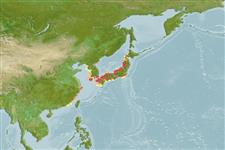Common names from other countries
Issue
Acanthogobius stigmothonus (Richardson, 1845) is considered as valid (from the South China Sea and Gulf of Tonkin) in Shibukawa & Iwata, 2013 (Ref. 93271).
Environment: milieu / climate zone / depth range / distribution range
Écologie
marin; eau douce; saumâtre démersal; amphidrome (Ref. 51243); profondeur 1 - 6 m (Ref. 96339). Temperate; 52°N - 23°N, 116°E - 143°E
Northwest Pacific: Russian Far East (from Amur to Peter the Great Gulf), Korean Peninsula, Bohai Sea, Yellow Sea and East China Sea of China, and Hokkaido to Kyushu of Japan.
Length at first maturity / Taille / Poids / Âge
Maturity: Lm 27.0 range ? - ? cm
Max length : 30.0 cm TL mâle / non sexé; (Ref. 2850); common length : 14.5 cm TL mâle / non sexé; (Ref. 12193)
Inhabits muddy and sandy bottoms along the shore of bays and estuaries, sometimes ascends rivers. Intertidal to at least 6.5 m (Ref. 96339). Oviparous, spawn in winter to early spring (Ref. 205). Eggs are deposited in Y-shaped nests (Ref. 205). Used in Chinese medicine (Ref. 12166).
Eggs are deposited near the base of the Y-shaped nest (Ref. 51058).
Shibukawa, K. and A. Iwata, 2013. Review of the East Asian gobiid genus Chaeturichthhys (Teleostei: Perciformes: Gobioidei), with description of a new species. Bull. Nat. Mus. Nat. Sci. Ser. A., Suppl. 7:53-66. (Ref. 93271)
Statut dans la liste rouge de l'IUCN (Ref. 130435)
CITES (Ref. 128078)
Not Evaluated
Menace pour l'homme
Harmless
Utilisations par l'homme
Pêcheries: commercial; Aquarium: Aquariums publics
Outils
Articles particuliers
Télécharger en XML
Sources Internet
Estimates based on models
Preferred temperature (Ref.
115969): 12 - 21.6, mean 17.9 (based on 189 cells).
Phylogenetic diversity index (Ref.
82804): PD
50 = 0.5156 [Uniqueness, from 0.5 = low to 2.0 = high].
Bayesian length-weight: a=0.00692 (0.00373 - 0.01284), b=3.01 (2.85 - 3.17), in cm Total Length, based on LWR estimates for this species & (Sub)family-body (Ref.
93245).
Niveau trophique (Ref.
69278): 3.4 ±0.3 se; based on diet studies.
Résilience (Ref.
120179): Milieu, temps minimum de doublement de population : 1,4 à 4,4 années (Preliminary K or Fecundity.).
Fishing Vulnerability (Ref.
59153): Low to moderate vulnerability (33 of 100).
